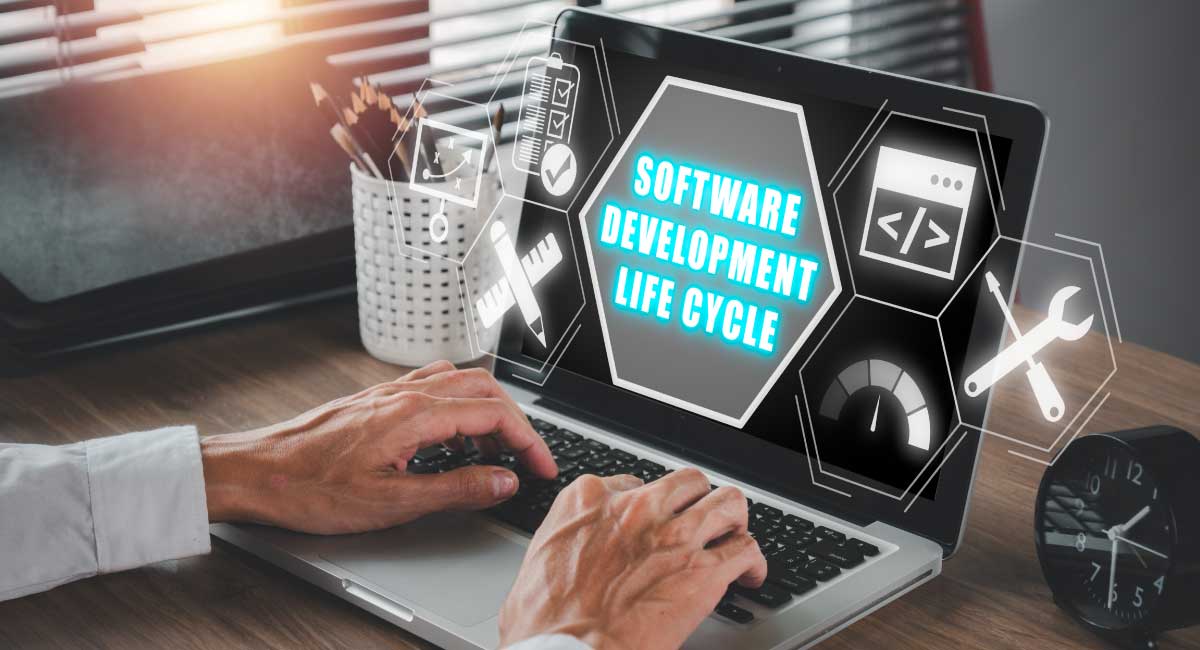You may have heard the saying, “Nearly every business is a software business today.” While this may sound like an overstatement, there is some truth to it. After all, modern businesses rely on software to operate. Hence, the need for a streamlined software development process and software developers has never been more urgent.
This article will discuss the software development life cycle (SDLC), taking you through its importance, stages, models, benefits and best practices. We will also discuss an industry-recognized web development program to help you master the skills required to implement a software development life cycle.
What is SDLC?
The software development life cycle is the practice of designing, developing, maintaining, and modifying software. It is a process to ensure that the software fulfills feature and business requirements. All software goes through an SDLC in every stage of software development, from inception to post-delivery services.
Also Read: What is Software Testing in Software Engineering?
The Role and Importance of SDLC
Software development is a cost- and time-intensive effort. Obstacles or gaps in any stage of development add to this cost and throw the operation timelines into disarray.
Hence, the development must occur systematically and lucidly. The SDLC is crucial in clarifying product requirements and planning for the development and potential failures. It helps you as a developer by putting all the cards on the table and facilitating a smooth product creation.
Let’s look at why the software development life cycle is important:
- SDLC streamlines product development for critical applications such as data security, infrastructure, or defense
- It does not leave any aspect of development, testing, or deployment to chance.
- You are aware of and prepared for potential bugs
- Your team has sufficient control over the entire process and clarity about the compliance required at each stage
- As the requirements are documented and firmly established, no team member can randomly add features during the process
- Each stage of SDLC is clearly defined, including its beginning, middle, and end
Examples of SDLC
Suppose a battery manufacturer requires inspection software to enhance the efficiency of the battery assembly line. Their team of software developers, tasked with the development of such software, will start collecting and analyzing data regarding the existing inspection systems in the factory, the flaws in the systems, the requirements of the new software, options to integrate the software, preferences, and ideas of the manufacturer, and the budget.
This is followed by finalizing the requirements of the software, including user experience, with the top management’s approval. The developers in the team now begin to build the code and user interface one by one within the defined framework. Sometimes, they may release a limited version to the quality and inspection department to test on their assembly line. This helps the developers to gauge what is and is not working. It also reduces the risk of redoing the entire software.
The final software is then integrated and tested on the assembly line. If the quality and inspection team observes that the software cannot inspect defective parts after a few days of use, they follow up with the developer team for further improvement.
Another example is the development of an educational website. The process will begin with a meeting between the top management, the development team, and the content team to understand the expectations and requirements. The development team will finalize the website’s features, CTA buttons, typography, and UI. The content team will provide any input at this point.
The SDLC will progress to the next stage of writing the code for the website and bringing it to life. The testing is then conducted in consultation with the content and operations teams, who prepare the material for the website. The uploading and working of the material and integrating the payment gateways come under the purview of the development and testing stages.
Once the top management is satisfied with the website, the developers will make it live, and the marketing team will take over and bring it to the public.
How Does SDLC Work?
SDLC works by breaking down the enormous task of software creation into manageable units. It further brings multiple parties together to work in synergy at an efficient pace. An appropriately applied SDLC simplifies the intricacies of the process.
It helps in task allocation to prevent overlap of responsibilities. The developers gain a disciplined approach and the flexibility to apply their knowledge in the given parameters. Finally, SDLC provides a means to revisit any stage of the software development if required, even if the software has been fully deployed.
Also Read: A Guide to Software Engineer Interview Questions
The Stages of the SDLC Process
SDLC comprises seven stages of software development:
#1. Planning and analysis
The first stage of SDLC entails understanding the requirements of the product. Your team leader and senior team members collate the information from the analyst, marketing and sales teams, and industry experts. They use the information to establish the paradigms of the project, including the project approach and the feasibility study. They then plan for the requirements of quality assurance and risk assessment.
#2. Specification of requirements
The second stage involves defining the parameters of the product, which need to be approved by the top management of your firm. The parameters include all the requirements to be considered during the entire project life cycle. The documents created in this stage are a software requirement specification (SRS), a Requirement Traceability Matrix document, and a Use Case document.
#3. Design
In this stage, the team members create a Design Document Specification (DDS) outlining all possible design approaches. The team leaders, top management, and stakeholders analyze this DDS for feasibility, the least cost, maximum quality and efficiency, and development time. The best design approach is then chosen, which includes the broad framework and details about the various modules required in the product.
#4. Development
Your group of software developers is then set to develop the product based on the specifications in DDS. This stage forms a major part of the SDLC, as the product gradually assumes form and feature as the team members build the programming code while following the established guidelines and the programming language used.
#5. Testing
Any new product must be tested to assess if it works correctly. Although testing is performed simultaneously for every stage of product development, the final testing before deployment is always the most critical of all. The product is examined for its proper operation on multiple systems, bugs, and defects. Your developers note the issues and revisit the product for suitable modifications.
#6. Deployment
After the product has been approved after successful testing and debugging, the marketing team in your business takes over to commercially release it in the target market. In certain cases, where the software is massive or requires feedback from real users, it is released in steps, with regular updates based on the users’ responses and comments.
#7. Maintenance
Software maintenance is critical to ensure user feedback resolution. Despite extensive testing, any product can face issues due to user styles and system variations. Hence, your developers have to be on the lookout for any negative reports that may require a software upgrade.
SDLC Models
The software development life cycle is performed by various models. The different models are designed to match the individual requirements of the software requirements. Here’s a comprehensive list of the various models you can use:
- Waterfall model
- Agile model
- Iterative model
- Rapid Application Development (RAD) model
- Spiral model
- V-shaped model
- Incremental model
- Big Bang model
- Prototype model
Also Read: Understanding Front-end vs. Back-end Development: Career Guide 2024
The Most Commonly Used SDLC Models
Of the numerous types of software development life cycle models, the most commonly used models are waterfall, Agile, and spiral.
The waterfall model is preferred because of its systematic progression. When new software has to be developed, all the involved parties may be shooting in the dark. Hence, a well-defined approach such as the waterfall model enables a step-by-step progression. Each stage is divided into substeps, and any issue with a sub-step has to be resolved before moving on. This helps identify and address issues early on in the process.
However, the waterfall model may require substantial time. Hence, if your business requires a software version quickly and with some known parameters, the Agile model is typically used. The Agile model has recently gained considerable importance, enabling your team to modify their requirements based on user feedback and market demands. So, in the Agile model, a beta version is released commercially, the users give their feedback, and the developer reworks the product to incorporate the suggestions and remove the reported bugs.
In some cases, such as in the spiral model, the software may be released only to a small focus group. This group tests the product and reports the bugs. The testing may be conducted by the development team members as well. The product is reverted to the planning stage and has to go through the subsequent stages to reach the testing step again. The cycle is repeated till all the requirements are satisfied. This prevents receiving negative feedback from consumers, especially in industries such as retail, where the risk of financial loss due to bad software is considerably high.
A good full stack development bootcamp can help you get acquainted with each of these models and more.
SDLC Vs. Other Lifecycle Management Methodologies
While the SDLC is of prime importance for software development, it is not the only available methodology. There are other types, such as systems development lifecycle and application development lifecycle.
The major difference between SDLC and the other lifecycle management methodologies is the scope of the work. While SDLC focuses primarily on software development, the systems development lifecycle considers hardware and software in its structure. Meanwhile, SDLC is not concerned with defining the hardware and infrastructure required for the software.
Further, SDLC provides options for further development and adaptation of the software as required by the market demands and user requirements. However, certain methodologies, like application lifecycle management (ALM), do not have this option. They work on the application until its successful deployment. If the application goes out of use or becomes redundant, ALM helps to phase it out but does not have a provision for adaptation or enhancement. There may be multiple SDLCs in a single ALM process.
How Does the SDLC Address Security?
With increased digitization accompanied by greater security risks, assessing how SDLC can help address security concerns is critical.
The main advantage of SDLC is that it is as flexible as it is rigid. It is rigid in the manner in which software development should be conducted. However, it is flexible enough to include security testing during the process. Consequently, potential security issues are defined in the planning stage, accounted for in the development stage, and assessed in the testing phase.
Such a process is also called a secure software development life cycle.
Also Read: Full Stack Web Developer Salary in 2024: Here’s What You Need to Know
Top Benefits of the Software Development Life Cycle
Now that we have established that SDLC holds staggering importance in the software industry, here’s how you will benefit from its implementation:
- Greater product quality
- Better visibility of the product development for the stakeholder
- Effective collaboration
- Improved planning and estimation
- Enhanced risk management
- Efficient utilization of resources
- Disciplined and systematic flow of product development
- Minimal delays and better response to obstacles
- Greater user satisfaction
- Improved response to user feedback
- Higher return on investment (ROI)
SDLC Best Practices
A good software development life cycle follows the established steps. A great SDLC incorporates multiple sources to ensure an enhanced software development effort. Here are some best practices you can follow to ensure the implementation of a great SDLC:
- Identify and detail the requirements
- Conduct infrastructural risk and security audits
- Train the team members on the best practices for coding, framework, tools, etc.
- Look at the big picture and note significant issues to be tackled head-on
- Explore new tools for code scanning, image recognition, etc., anything that can reduce mundane activities
- Identify opportunities for practical use cases and user personas
Master SDLC and Web Development Skills
The demand for software developers in the US will only grow. Anyone aspiring to become a part of this must know the multiple aspects of web development.
Our web development program has been specially curated to train you in full stack web development, SDLC, API endpoints and communication, and DevOps, to name a few. Industry experts will instruct you with years of experience. Seize this opportunity to work on practically applicable projects and boost your career in web development.
Frequently Asked Questions
- What are the software development life cycle phases?
The major SDLC phases are planning and analysis, requirements specification, design, development, testing, deployment, and maintenance. The phases may be combined for specific requirements.
- What is SDLC?
SDLC stands for Software Development Life Cycle, a process adopted to streamline software development with minimum hiccups and greater efficiency.
- Is SDLC waterfall or agile?
Both waterfall and agile are SDLC models. The selection of either model depends on the product being developed and its requirements.
You might also like to read:
2024 Full Stack Developer Roadmap: A Comprehensive Guide
What Do Coders Do and What Kind of Coder Salary Can You Expect?
React Developer Tools: A Comprehensive List






